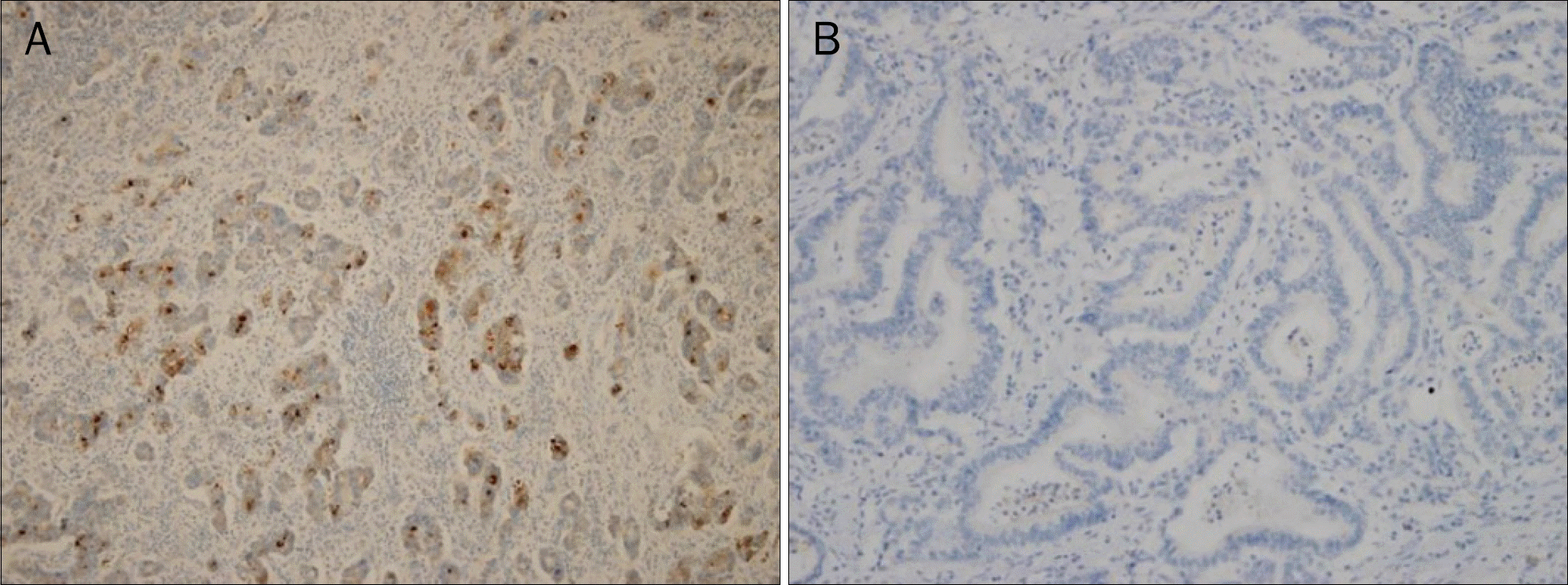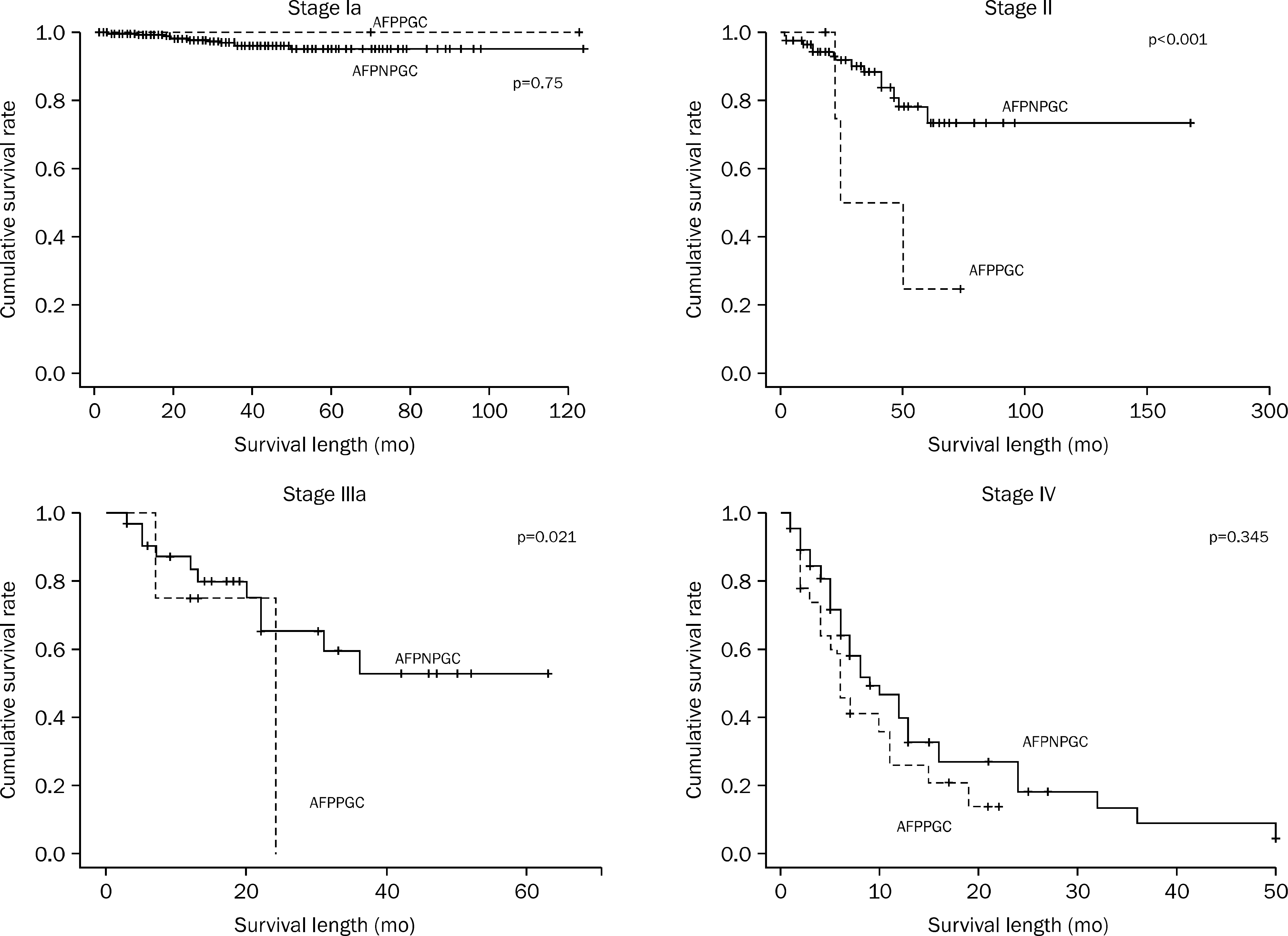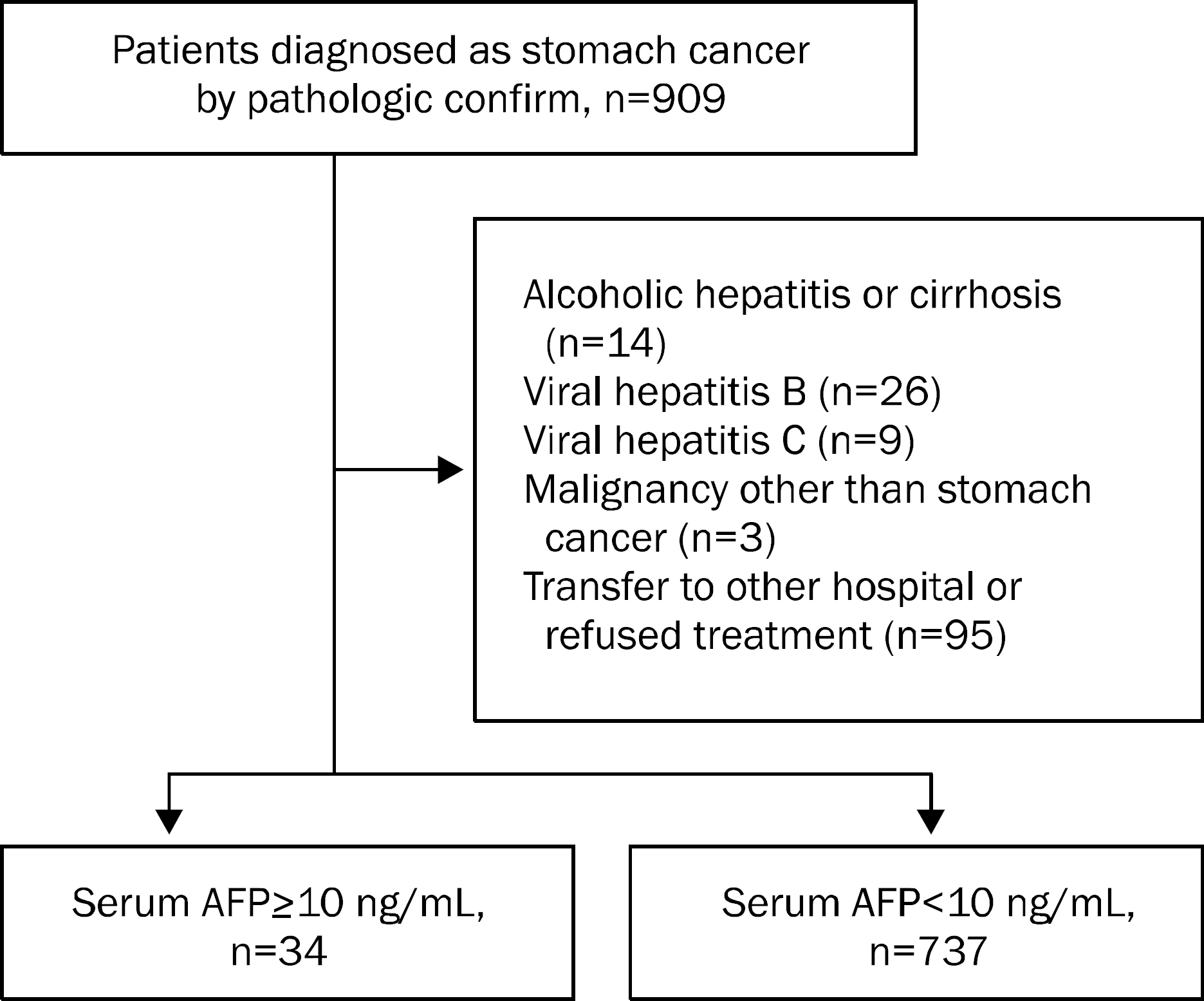Abstract
Background/Aims
Several studies reported a subgroup of gastric cancer patients showing elevated serum alpha-fetoprotein (AFP) at the time of diagnosis. We investigated the clinicopathological characteristics and prognostic factors of AFP producing gastric cancer (AFPPGC) by comparing with AFP non-producing gastric cancer (AFPNPGC).
Methods
A total of 909 patients were diagnosed with gastric cancer from January 2005 to March 2013 at Gyeongsang National University Hospital and their AFP levels were measured at the time of diagnosis. After excluding 138 patients with underlying liver diseases, 34 patients with elevated serum AFP level over 10 mg/mL were assigned to AFPPGC group and the remaining 737 patients with serum level of AFP below 10 ng/mL were assigned to AFPNPGC group.
Results
The median survival length was shorter in AFPPGC group than AFPNPGC group (18.3±25.5 months vs. 30.0±22.0 months, p=0.004). The incidence of liver metastasis (47.1% vs. 3.3%, p<0.001) and lymph node metastasis (91.2% vs. 31.6%, p<0.001) was significantly higher in AFPPGC group. The probability of encountering metachronous liver metastasis after the operation was higher in AFPPGC group (44.4% vs. 2.0%, p<0.001). Multivariate analysis revealed that patients in the AFPPGC group who received chemotherapy (p=0.037) or underwent operation (p=0.001) had a better survival rate.
Go to : 
References
1. Harper ME, Dugaiczyk A. Linkage of the evolutionarily-related serum albumin and alpha-fetoprotein genes within q11–22 of human chromosome 4. Am J Hum Genet. 1983; 35:565–572.
2. Fujii H, Ichikawa K, Takagaki T, et al. Genetic evolution of alpha fetoprotein producing gastric cancer. J Clin Pathol. 2003; 56:942–949.
3. Bourreille J, Metayer P, Sauger F, Matray F, Fondimare A. Existence of alpha feto protein during gastric-origin secondary cancer of the liver. Presse Med. 1970; 78:1277–1278.
4. Bruix J, Sherman M. Practice Guidelines Committee, American Association for the Study of Liver Diseases. Management of hepatocellular carcinoma. Hepatology. 2005; 42:1208–1236.

5. Karayiannakis AJ, Kakolyris S, Giatromanolaki A, et al. Hepatoid Adenocarcinoma of the Gallbladder: Case Report and Literature Review. J Gastrointest Cancer. 2011. [Epub ahead of print].
6. Liu Q, Bannan M, Melamed J, Witkin GB, Nonaka D. Two cases of hepatoid adenocarcinoma of the intestine in association with inflammatory bowel disease. Histopathology. 2007; 51:123–125.

7. Mokrim M, Belbaraka R, Allaoui M, et al. Hepatoid adenocarcinoma of the lung: a case report and literature review. J Gastrointest Cancer. 2011. [Epub ahead of print].

8. Liu X, Cheng Y, Sheng W, et al. Clinicopathologic features and prognostic factors in alpha-fetoprotein-producing gastric cancers: analysis of 104 cases. J Surg Oncol. 2010; 102:249–255.

9. Koide N, Nishio A, Igarashi J, Kajikawa S, Adachi W, Amano J. Alpha-fetoprotein-producing gastric cancer: histochemical analysis of cell proliferation, apoptosis, and angiogenesis. Am J Gastroenterol. 1999; 94:1658–1663.
10. Joo YH, Jung HY, Kang GH, et al. ClinicoPathologic Characteristics of the Alpha-fetoprotein Producing Gastric Carcinoma. Korean J Gastroenterol. 2000; 36:54–60.
11. Ishikura H, Fukasawa Y, Ogasawara K, Natori T, Tsukada Y, Aizawa M. An AFP-producing gastric carcinoma with features of hepatic differentiation. A case report. Cancer. 1985; 56:840–848.

12. Liu X, Sheng W, Wang Y. An analysis of clinicopathological features and prognosis by comparing hepatoid adenocarcinoma of the stomach with AFP-producing gastric cancer. J Surg Oncol. 2012; 106:299–303.

13. Chun H, Kwon SJ. Clinicopathological characteristics of alpha-fetoprotein-producing gastric cancer. J Gastric Cancer. 2011; 11:23–30.

14. Ramsey WH, Wu GY. Hepatocellular carcinoma: update on diagnosis and treatment. Dig Dis. 1995; 13:81–91.

15. Stuart KE, Anand AJ, Jenkins RL. Hepatocellular carcinoma in the United States. Prognostic features, treatment outcome, and survival. Cancer. 1996; 77:2217–2222.

16. Christiansen M, Høgdall CK, Andersen JR, Nørgaard-Pedersen B. Alpha-fetoprotein in plasma and serum of healthy adults: pre-analytical, analytical and biological sources of variation and con-struction of age-dependent reference intervals. Scand J Clin Lab Invest. 2001; 61:205–215.
17. Uefuji K, Ichikura T, Tamakuma S. Roles of histological findings and serum AFP levels in the prognosis of AFP-producing gastric cancers. Jpn J Clin Oncol. 1994; 24:135–140.
18. Motoyama T, Aizawa K, Watanabe H, Fukase M, Saito K. Alpha-fe-toprotein producing gastric carcinomas: a comparative study of three different subtypes. Acta Pathol Jpn. 1993; 43:654–661.
19. Chang YC, Nagasue N, Kohno H, et al. Clinicopathologic features and long-term results of alpha-fetoprotein-producing gastric cancer. Am J Gastroenterol. 1990; 85:1480–1485.
20. McIntire KR, Waldmann TA, Moertel CG, Go VL. Serum alpha-fe-toprotein in patients with neoplasms of the gastrointestinal tract. Cancer Res. 1975; 35:991–996.
21. Su JS, Chen YT, Wang RC, Wu CY, Lee SW, Lee TY. Clinicopathological characteristics in the differential diagnosis of hepatoid adenocarcinoma: a literature review. World J Gastroenterol. 2013; 19:321–327.

22. Kumashiro Y, Yao T, Aishima S, et al. Hepatoid adenocarcinoma of the stomach: histogenesis and progression in association with intestinal phenotype. Hum Pathol. 2007; 38:857–863.

23. Kaji M, Yonemura Y, Harada S, Liu X, Terada I, Yamamoto H. Participation of c-met in the progression of human gastric cancers: anti-c-met oligonucleotides inhibit proliferation or invasiveness of gastric cancer cells. Cancer Gene Ther. 1996; 3:393–404.
24. Kataoka H, Miura Y, Joh T, et al. Alpha-fetoprotein producing gastric cancer lacks transcription factor ATBF1. Oncogene. 2001; 20:869–873.

25. Jeong SH, Shim HJ, Hwang JE, et al. A case of gastric hepatoid adenocarcinoma misdiagnosed as an extragonadal germ cell tumor. Korean J Med. 2007; 73:107–111.
26. Kang GH, Kim YI. Hepatoid adenocarcinoma of the stomach: a pathologic analysis of 14 cases. Korean J Pathol. 1994; 28:620–628.
27. Yong KJ, Gao C, Lim JS, et al. Oncofetal gene SALL4 in aggressive hepatocellular carcinoma. N Engl J Med. 2013; 368:2266–2276.

28. Ikeda H, Sato Y, Yoneda N, et al. α-Fetoprotein-producing gastric carcinoma and combined hepatocellular and cholangiocarcinoma show similar morphology but different histogenesis with respect to SALL4 expression. Hum Pathol. 2012; 43:1955–1963.

29. Zhang JF, Shi SS, Shao YF, Zhang HZ. Clinicopathological and prognostic features of hepatoid adenocarcinoma of the stomach. Chin Med J (Engl). 2011; 124:1470–1476.
30. Usuba T, Toyama Y, Watanabe K, Kashiwagi H, Yanaga K. Combination chemotherapy using TS-1, Paclitaxel and cisplatin for multiple lung metastases from AFP-producing gastric cancer: a case report. Hepatogastroenterology. 2007; 54:1302–1304.
Go to : 
 | Fig. 2.(A) Immunohistochemical staining in AFP-producing gastric cancer. Gastric adenocarcinoma cells express AFP in the cytoplasm of some tumor cells and in the glandular lumina (AFP, ×100). (B) Immunohistochemical staining in AFP non-producing gastric cancer. Gastric adenocarcinoma in this case is negative for AFP (×100). |
 | Fig. 3.Survival of gastric cancer patients compared with those of the same stage according to AFP production. Survival of AFPPGC is shorter than that of AFPNPGC with same stage. AFPPGC, AFP producing gastric cancer; AFPNPGC, AFP non-producing gastric cancer. |
Table 1.
Case Series of Patients with Alpha-fetoprotein-producing Gastric Cancer
Table 2.
Comparison between AFP-producing Gastric Cancer Patients and AFP Non-producing Gastric Cancer
Table 3.
Univariate Survival Analysis of All Gastric Cancer Patients according to Clinical Factors
Table 4.
Independent Prognostic Factors in Multivariate Analysis by Cox Proportional Hazard Model in All Patients with Gastric Cancer
Table 5.
Univariate Analysis of Factors Affecting Survival in Patients with AFP-producing Gastric Cancer
Table 6.
Survival of Gastric Cancer Patients with Liver Metastasis according to AFP Production




 PDF
PDF ePub
ePub Citation
Citation Print
Print



 XML Download
XML Download